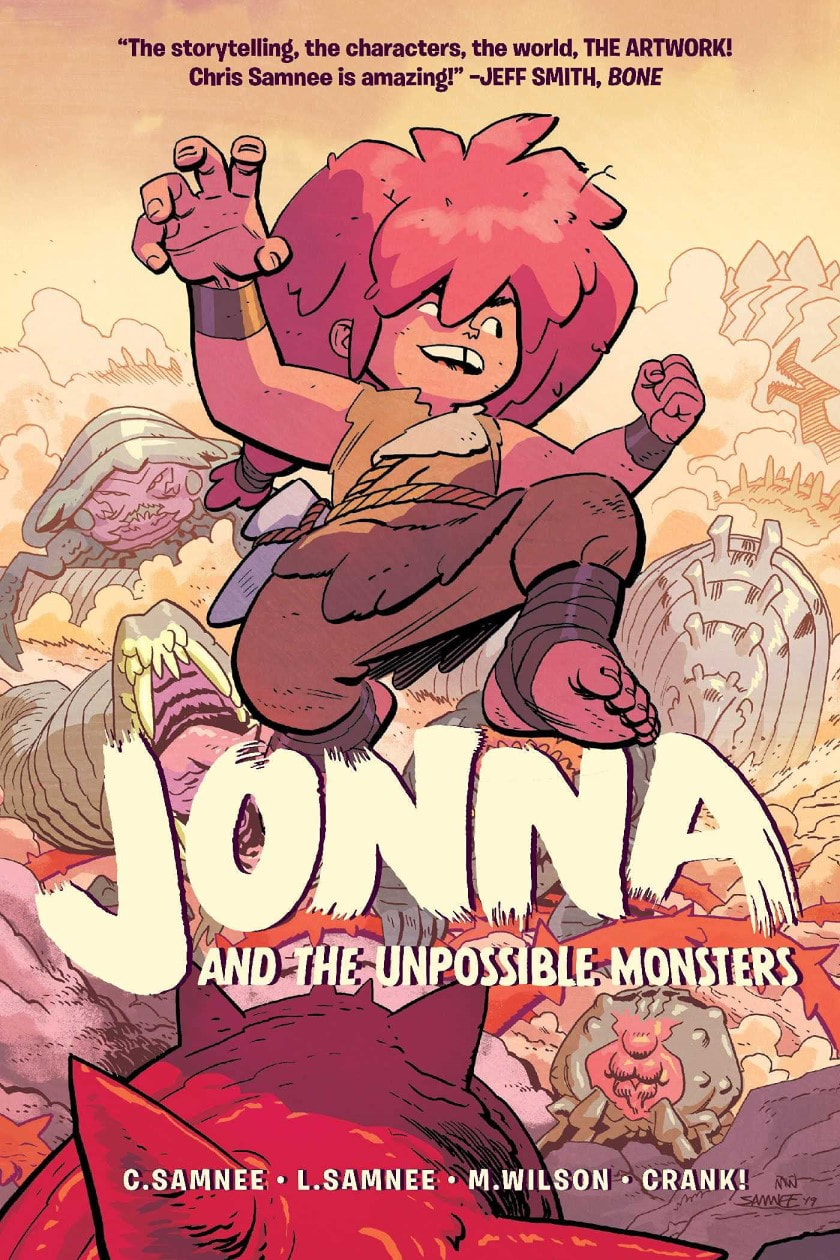|
Jonna and the Unpossible Monsters. Book One. Written by Chris Samnee and Laura Samnee. Drawn by Chris Samnee. Colors by Matthew Wilson. Lettering by Crank! (Christopher Crank). Oni Press, August 2021. ISBN 978-1620107843, $US12.99. 112 pages. Jonna and the Unpossible Monsters has a premise that was just waiting to happen, one that somebody, somehow, had to get around to: a postapocalyptic children's fantasy about fighting giant, kaiju-like monsters. There's a touch of Jack Kirby's Kamandi, the Last Boy on Earth about this, and maybe a touch of Pacific Rim too. Co-creators Laura Samnee and Chris Samnee describe Jonna as a story they "could share with [their] three daughters," something created "for them" but also "inspired by them"; the comic, though, will appeal to action-starved fans of Chris Samnee's work on such superhero comics as Thor the Mighty Avenger, Daredevil, Black Widow and Captain America (or his current martial arts fantasy with writer Robert Kirkman, Fire Power). The heroic Jonna is a wild, monster-clobbering girl with a whiff of Ben Grimm or Hellboy. She comes across as untrammeled, almost feral, yet delightful. When Jonna goes missing in a ruined, kaiju-ravaged world, her older sister Rainbow – the more fretful, responsible one, naturally – tries to find her, then corral and (re)civilize her. Jonna, though, remains a unpredictable force of nature. You don't need to know much more; the first half dozen pages give you whopping big monsters, and plenty of synthetic worldbuilding. There's a sense of the familiar about all of it, but novelty and excitement too. By now it's almost a cliché to speak of Chris Samnee's masterful storytelling and sheer chops (I've paid tribute before). It is true that I will read just about anything drawn by him, especially when it's colored by Matt Wilson, his steady collaborator for more than a decade. Granted, I got impatient with Fire Power within a few issues. Though I dug its bang-up start, Fire Power strikes me as a shopworn White martial arts fantasy à la Iron Fist; it's tropey, and conceptually a bit tired. I've stayed with it, however, because of Samnee and Wilson's visuals, and it has become my monthly dose of old-school craft and loveliness, balancing breathless action with an Alex Toth-like elegance. Samnee manages to be polished and rugged at once; his drawing offers classicism and grace, but with a terrific infusion of energy. Jonna, I think, may be the best thing he has ever done: the pages sing, and roar, and astonish with their gusty action and playfulness. Freed somewhat from the stylized naturalism of mainstream superhero comics (though that skill set is still very much in evidence), Jonna cartoons with a joyful freedom. Wilson's coloring, too, is eye-wateringly good. All this is my way of saying that Jonna is craftalicious and affords plenty of gazing and rereading pleasure after the initial readerly sprint. But what does it amount to? On some level, it remains a kind of superhero comic, not only because Jonna packs a mean punch but also because a couple of other characters discovered along the way, Nomi and Gor, are seasoned fighters as well (Nomi boasts powerful prosthetic arms). So, this is a slugfest. But there's more: moments of poignancy, sisterly anxiety, and Jonna's weird, ferine energy and charming social cluelessness. And the Samnees allow a certain melancholy to creep in; the world of Jonna is a fallen one, full of sundered families, lost loved ones, bereavements. In one scene, a ragtag group of survivors huddles around a fire, and their dialogue says a lot: My whole family gone. My home destroyed. My village destroyed. Everything destroyed. Without pressing the point, the story has a genuinely apocalyptic feel that, to me, reeks of COVID. That it manages to be cockeyed and funny at the same time is no small feat. Though billed as a children's story, Jonna is just as much for grownups. The book (originally serialized in floppy form) splits the difference between direct market-oriented cliffhanger series and middle-grade graphic novel, so it's courting multiple audiences. Moreover, a theme of "families and belonging" (as the Samnees put it) threads through the book, familiar from many an animated family film, and like such films Jonna offers adults a kind of reassurance even as it aims for kids. That is, it offers childhood as a cure for ruin and heartbreak. The basic ingredients are familiar – there's nothing revolutionary about this tale – but I'm at a time in my life where seeing kids wallop monster does me a world of good. This first volume (a second is promised for Spring 2022) sets up some mysteries, not least the mystery of Jonna herself, and doesn't answer very many questions, but I enjoy paging through it and rereading it. In fact, I enjoy it more than I can say. PS. The excellent magazine PanelxPanel, by Hass Otsmane-Elhaou and company, devoted a good chunk of its May 2021 issue (No. 46) to Jonna, and includes a revealing interview with Chris Samnee. Plus, the issue contains other articles on depictions of children and on young readers' graphic novels. Well worth checking out!
0 Comments
Your comment will be posted after it is approved.
Leave a Reply. |
Archives
June 2024
|




 RSS Feed
RSS Feed
